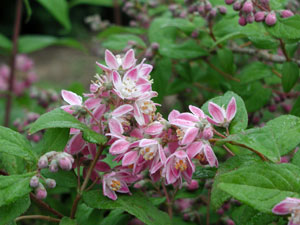Resource Library
Plant of the Week: Fuzzy Deutzia
The University of Arkansas System Division of Agriculture does not promote, support or recommend plants featured in "Plant of the Week." Please consult your local Extension office for plants suitable for your region.
Plant of the Week
Fuzzy Deutzia
Latin: Deutzia scabra

Something old is new again. In gardening this truism that cannot be denied because plants and fashion seem to be on a giant lazy Susan that continually rotates with everything eventually coming back in vogue.
I personally like to see old favorites return because there is always room in the garden for something new and different, even if it is old. Deutzias, the hundred-year-old deciduous shrubs of our great grandmother’s gardens, are now being seen with more regularity than they were a few years back.
About 60 species of Deutzias are described with most originating in eastern China and Japan. They belong to the hydrangea family and grow as deciduous shrubs 3- to 8-feet tall and wide. The best of the small-growing species is the white-flowering slender deutzia (Deutzia gracilis) that reaches 3 feet in height and is covered in a mass of snow white blooms that appear just as the late season azaleas are finishing. Deutzia x lemoinei is an 8 foot tall, coarse textured, white flowered shrub that blooms in mid-May and still has a place in cold locations in this country where more refined shrubs will not survive low winter temperatures.
But the Deutzia renaissance, if you can call it that, seems to be centered on Deutzia scabra, the Fuzzy Deutzia from Japan. Though the species can reach 8 feet in height and spread, most of the cultivars being offered are a more modest 3 to 4 feet in height. Like all deutzias, this species is low branched and brushy in nature. It has coarse, opposite 2- to 4-inch long leaves that have a sandpaper texture on the upper surface caused by clusters of leaf pubescence that radiate outward in a cluster of 10 to 15 hairs that can be easily seen with light magnification.
The main appeal of this species is that many of its cultivars have pink flowers. ‘Strawberry Fields’ is one of the newest ones being offered which has pink buds in a 6-inch long panicle that opens with pink, one-inch stars marked with a white edge. The blooms open over about a three-week period so the plant has a long display period. A number of other selections of this species are offered but it will take some hunting to find them.
Deutzias were described by the early plant explorers in the Orient but were not introduced into cultivation in the West until 1822. But even then they didn’t attract much attention until European nurserymen such as Victor Lemoine (1823 – 1911) began hybridizing them in the late 19th century. They enjoyed popularity in American gardens until WWII, at which time evergreens became the rage and all the old-fashioned deciduous shrubs were phased out.
Fuzzy deutzia is hardy from zones 5 through 8 and grows in any good garden soil. It grows in full sun but will produce good displays in moderately heavy shade. I grow my plant amongst azaleas and like it because it extends the blooming season for the bed. Deutzias are spring bloomers that flower on year-old wood, so if pruning is needed to control height, prune just after they finish blooming. They are not bothered by serious insect or disease problems.
By: Gerald Klingaman, retired
Retired Extension Horticulturist - Ornamentals
Extension News - June 21, 2013
The University of Arkansas System Division of Agriculture does not maintain lists of retail outlets where these plants can be purchased. Please check your local nursery or other retail outlets to ask about the availability of these plants for your growing area.